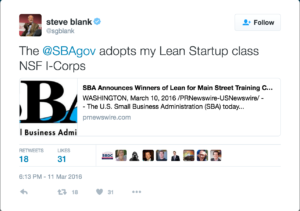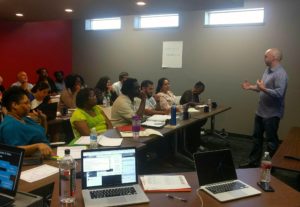Main Street Entrepreneurs can learn from Tech Start up Methodology
(This article is about applying lean startup methods to Main Street or traditional small businesses and features McLennan Small Business Development Center’s involvement in the SBA’s Lean for Main Street Training Challenge. McLennan SBDC is now scaling its pilot regionally and offering the next Introduction to Customer Discovery cohort at the Addison TreeHouse, in Addison, Texas, from January 10 – 31, 2017. For more information and to apply, click here.)
By Jane Herndon
Too often, entrepreneurs fall in love with their invention or business idea and assume everyone else will love it, too.
Full of confidence, they dive immediately into execution with little afterthought. They make a significant up-front investment in a brick-and-mortar location, buy equipment, hire staff and open their doors. Ready, set, go!
Some might even approach it more thoughtfully and actually write a traditional business plan. Legal structure? Check. Marketing plan? Check. Financial projections? Check.
Though very different approaches, both focus on the tactical “can I build this product or business?” versus the strategic “should I build it?” But what if you build something nobody wants?
More businesses fail from lack of customers than from lack of capital or marketing or product failure. Only half of all establishments survive five years or longer. (1)
Get Out of the Building
 To address uncertainty and improve the odds of business success, Steve Blank, serial entrepreneur and father of the Lean Startup movement, and his protégé, Eric Ries, have pioneered an evidence-based approach to entrepreneurship. What the scientific method did for accelerating scientific breakthroughs, lean startup promises to do for business innovation.
To address uncertainty and improve the odds of business success, Steve Blank, serial entrepreneur and father of the Lean Startup movement, and his protégé, Eric Ries, have pioneered an evidence-based approach to entrepreneurship. What the scientific method did for accelerating scientific breakthroughs, lean startup promises to do for business innovation.
And it does so by turning the decades-old formula for writing a business plan on its head. Instead of diving in and/or launching one’s company with a business plan full of unproven assumptions (guesses), it urges entrepreneurs to “get out of the building” and in front of a volume of prospective customers to gain first-hand insight into their problems, needs and motivations. This customer-centric approach emphasizes rapid experimentation over elaborate planning, stakeholder feedback (facts) over guesswork, and placing “small bets” over big, up-front investment. It addresses the question: “is this a business worth pursuing?”
Today Blank’s lean startup class is the world’s leading pre-accelerator program. It is also the core curriculum of the National Science Foundation’s (NSF) Innovation Corps, known as I-Corps™, the nation’s premier, federally funded entrepreneurship program. The NSF uses lean to help scientists commercialize or turn their ideas into businesses.
Last year, President Obama announced plans to scale up the National Science Foundation I-Corps program with new and expanded Federal agency partnerships, the U.S. Small Business Administration (SBA) among them. McLennan Small Business Development Center is honored to participate in the first wave of the SBA’s I-Corp-inspired innovation effort.
Everybody Has a Plan Until They Get Punched in the Mouth
The first piece of advice most would-be entrepreneurs get is “go write a business plan.” And it’s true if you need a bank loan. It’s also true that few business plans survive first contact with customers. Or, as Mike Tyson once said about his opponents’ prefight strategies: “Everybody has a plan until they get punched in the mouth.”
Unlike web startups, brick-and-mortar businesses require considerable up-front financial investment just to open their doors – a time when uncertainty is highest. Creating business plans and financial models based on secondary research and guesses – without testing these assumptions first – can waste valuable time, lead to over-investing and create a false sense of security. The better up-front investment is to do some reality checks with stakeholders to find out “you don’t know what you don’t know” and whether you’re even solving a real need.
Finally, small business owners, and the people who love them, have a lot of skin in the game. The majority bootstraps their companies with their own funds or those of friends and family. According to the SBA site referenced earlier, the most common source of capital used to finance small business startup and expansion is personal or family savings (21.9%), followed by business profits and loans (5.7%). Simply put, when small businesses succeed, communities thrive. When small businesses “get punched in the mouth” and fail, families, communities and local economies suffer.
Lean for Main Street Pilot
While lean resources and programs are commonly available online and through accelerators, universities and events like Startup Weekend, they’ve been geared to tech startups. Small business owners and first-time entrepreneurs may be less aware of lean methods and more importantly, how to effectively apply them.
To this end, the U.S. Small Business Administration’s (SBA) Office of Entrepreneurial Development created the Lean for Main Street Training Challenge to bring the benefits of lean methodology to traditional “Main Street” businesses. The purpose of the challenge is to develop and pilot a variety of lean innovation curricula for small businesses and scale these teaching innovations to a wider audience. In January, they conducted their own lean experiment with the national SBA resource partner network by launching the prize competition on the federal government’s open innovation platform, Challenge.gov.
 In March, five winners were announced nationwide, including McLennan SBDC. Three weeks after the award announcement, Strategist Chris McGowan and I joined the other prize winners from San Francisco, metropolitan DC, Pittsburgh, and Mississippi to observe a national I-Corps program in Washington, DC for a 6-week train-the-trainer program.
In March, five winners were announced nationwide, including McLennan SBDC. Three weeks after the award announcement, Strategist Chris McGowan and I joined the other prize winners from San Francisco, metropolitan DC, Pittsburgh, and Mississippi to observe a national I-Corps program in Washington, DC for a 6-week train-the-trainer program.
After additional mentorship from Max Green, national I-Corps instructor based in Austin, we launched the Introduction to Customer Discovery short course (aka Customer Discovery Workshop) in August. We sought to include entrepreneurs and social innovators not typically exposed to lean startup methods and cohort-based learning. Applicants were encouraged to apply as 2-3 member teams; we selected a group of 8 teams, called a cohort. The majority of teams were women- and minority-led.
The Introduction to Customer Discovery short course is designed to help pre-venture, startup and early-stage companies establish product-market fit and improve their odds of success. Ideal candidates are those who either have an idea for an innovative new business or who’ve recently started a promising business, but aren’t getting the customer traction they anticipated.
We use a “flipped classroom” approach. All coursework is done prior to class to allow for participant-led presentations, inquiry and direct feedback from instructors. On the opening day, teams present their initial business thesis and assumptions about customer segments and value propositions. They are tasked with interviewing 10 or more potential customers every week to determine whether what they’re offering solves a real market need.
While the class runs over a three-week period, participants attend only two days of classes – the opening and closing workshop. This means, that after the opening workshop, teams “get out of the building” and work on their own schedule, talking to potential customers about their business problems and needs. Team members record their interview findings online and check in remotely with instructors via webinar for another round of instructor feedback at the halfway point. The group reconvenes on the final day where they present their findings, next steps and “lessons learned.”
Since we have limited time, instructors will push, challenge, and question in order to accelerate insight and learning cycles. Exchanges are direct, open, and tough. This approach may seem harsh or abrupt, but teaches how to challenge your own thinking and bias, and appreciate that as a business owner, you will need to learn and evolve faster than ever imagined.
Finding out if your product/service is a business opportunity worthy of pursuit – based on a volume of customer feedback – is considered “success.”
A McLennan SBDC client sums up their short course experience this way:
“This was a tectonic shift in our approach and understanding of what we have to do to succeed… The combination of the lean startup content from Steve Blank, etc., plus the brutally honest & challenging feedback is really powerful…it’s in a league of its own…”
Takeaways
- Unanticipated “punches in the mouth” can and will impact your business plan. The lean approach helps manage this uncertainty with an evidence-based, customer-centric approach to entrepreneurship.
- Small businesses are a creative entrepreneurial force and the backbone of our economy. Lean methods can catalyze economic growth and innovation by helping ventures launch more quickly, cheaply and with less risk.
- An entrepreneurial development program is only as good as the number of people it can reach. Successful ecosystem partnerships are key to taking lean innovation mainstream.
 Jane Herndon grew up as a child laborer in the family business and was bitten by the entrepreneurship bug early. A technology industry veteran, she retired from a glamorous business-modeling career to work with the SBDC. When not serving as a business mentor, she can be found down the rabbit hole with Buckminster Fuller, her rescue rabbit. For bona fides, see LinkedIn. Contact Jane at [email protected], if your organization is interesting in partnering to bring lean startup methods to local entrepreneurs and innovators.
Jane Herndon grew up as a child laborer in the family business and was bitten by the entrepreneurship bug early. A technology industry veteran, she retired from a glamorous business-modeling career to work with the SBDC. When not serving as a business mentor, she can be found down the rabbit hole with Buckminster Fuller, her rescue rabbit. For bona fides, see LinkedIn. Contact Jane at [email protected], if your organization is interesting in partnering to bring lean startup methods to local entrepreneurs and innovators.
The Act Locally Waco blog publishes posts with a connection to these aspirations for Waco. If you are interested in writing for the Act Locally Waco Blog, please email [email protected] for more information.
Notes:
(1) U.S. Small Business Administration, Office of Advocacy, Frequently Asked Questions, https://www.sba.gov/sites/default/files/advocacy/SB-FAQ-2016_WEB.pdf (2016)
